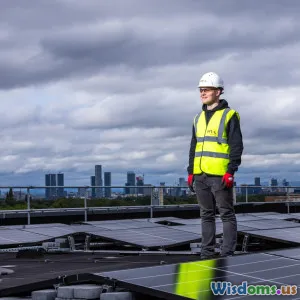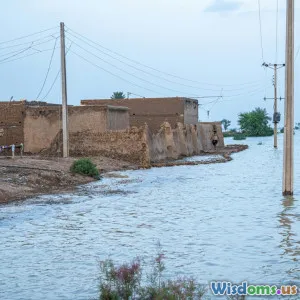
Urban Survival Myths Are City Rooftops Safe During Disasters
9 min read Exploring if city rooftops truly offer safety during disasters and debunking urban survival myths with expert insights. (0 Reviews)
Urban Survival Myths: Are City Rooftops Safe During Disasters?
Introduction
When chaos strikes an urban environment, countless survival strategies flood social media and emergency preparedness circles. One piece of advice that often emerges is to seek refuge on city rooftops during disasters such as floods, earthquakes, or civil unrest. But is this urban survival myth rooted in reality? Are rooftops really a sanctuary when danger looms? This comprehensive analysis will unpack this popular belief, investigate structural realities, evaluate possible risks, and offer viable alternatives for urban dwellers facing emergencies.
The Historical Appeal of Rooftops in Disaster Scenarios
Cultural and Media Influences
Rooftops often symbolize refuge and vantage in movies, documentaries, and historical accounts. Consider the classic image of flood survivors clinging to rooftops during Hurricane Katrina in 2005. Such visuals have cemented the idea that rooftops are reliable last resorts. Similarly, some urban protest coverage shows rooftop fortifications, portraying them as strategic safe points. This media portrayal embeds the rooftop-as-refuge concept deeply in public consciousness.
Traditional Survival Wisdom
In the context of floods, especially in coastal or low-lying cities, rooftops can represent the highest accessible ground. In these cases, seeking higher elevation is indisputably crucial. Yet the nuances of safety involve more than mere altitude.
Structural and Safety Challenges of City Rooftops During Disasters
Roof Design and Load Capacity
Most urban rooftops are not constructed for long-term human occupancy. Residential and commercial roofs vary greatly in their materials, structural integrity, and maintenance. Generally, roofs are designed to support their own weight plus additional static loads like snow or equipment, not a crowd of people.
According to the American Society of Civil Engineers (ASCE), roofs in flood-prone or earthquake-prone regions might adhere to specific codes, but these often don’t accommodate mass gatherings or prolonged sheltering. The risk of collapse escalates if the roof isn’t maintained or subjected to added stresses like wind or debris.
Exposure to Weather and Environmental Hazards
Rooftops expose individuals to the elements without shelter.
- Heat and sun exposure: Urban heat island effects can cause rooftop temperatures to soar well above street level.
- Storm and wind damage: High winds or flying debris during hurricanes or tornadoes pose serious danger.
- Lack of access to water and supplies: Immediate needs like hydration, communication, and first aid are limited.
Accessibility Issues
In high-rise buildings, accessing rooftops during a disaster can be complicated or impossible.
- Elevators might fail: Power outages or structural damage may force using stairs, which could be blocked.
- Locked rooftop access: Many roofs require keys or codes for entry.
- Crowding and panic: In emergency evacuations, uncoordinated rooftop access can lead to bottlenecks or trampling.
Real-World Examples: Evaluating Rooftop Safety in Past Disasters
Hurricane Katrina (2005)
During Katrina, thousands stranded on rooftops demanded rescue. The National Weather Service expressed concerns about waterborne diseases, dehydration, and extended exposure leading to worsened casualties. Rooftop refugee situations in New Orleans highlighted both the utility and the risks of this refuge.
The Mexico City Earthquake (2017)
Multiple buildings suffered partial roof collapses. Roof stability was compromised due to structural stress in aftershocks, proving that rooftops could quickly become precarious.
Urban Flooding in Mumbai, India
Locals often seek rooftops during monsoon floods. However, overcrowding and poor structural maintenance result in periodic collapses, some causing fatal accidents.
Debunking Common Urban Survival Myths About Rooftops
Myth 1: Rooftops Are Always the Safest Place in a Flood
While elevated, rooftops don't guarantee safety. Floodwaters can compromise building structures from below, especially in older or poorly built buildings. A U.S. Geological Survey report emphasized that floodwaters weaken foundations unpredictably, turning roofs into deadly traps if the building collapses.
Myth 2: Rooftops Offer Good Visibility to Locate Rescuers
Yes, aerial rescuers can spot people on roofs better than those stranded at street level. However, roofs cluttered with HVAC systems, antennas, or inaccessible ledges reduce the chance that rescuers can land or reach survivors effectively.
Myth 3: All Urban Rooftops Are Structurally Sound and Socially Accessible in a Crisis
Unfortunately, many urban rooftops are off-limits or unsafe loaded with mechanical equipment or fragile materials like glass panels or green roofs. Plus, many buildings have restricted access for security reasons.
Alternatives and Best Practices for Urban Survival Planning
Vertical Evacuation Structures
Some earthquake preparedness programs in California recommend vertical evacuation zones—multi-story reinforced areas designed to resist liquefaction or flooding, offering safer refuge than typical roofs. For example, parks or podiums within spaces like San Francisco's Mission Bay act as vertical evacuation sites rather than generic rooftops.
Emergency Community Shelter Mapping
Cities like New York and Tokyo maintain predefined shelters equipped with essentials that present far safer options than bare rooftops. Awareness and access to these could save lives.
Personal Emergency Kits and Planning
Preparedness reduces dependence on risky rooftop refuge. Urban survival experts advocate for:
- Portable water and nutrient supplies
- Battery-powered communication devices
- First aid materials
- Maps of safe evacuation routes
The Community Preparedness Survey highlighted that well-prepared citizens had 45% better survival odds in urban disasters.
Expert Opinions and Recommendations
Dr. Emily Harris, Urban Disaster Risk Analyst, states:
"Rooftops can offer temporary refuge predominantly in isolated situations like sudden floods, but they’re no substitute for sturdy emergency shelter designs and well-prepared evacuation planning."
The Federal Emergency Management Agency (FEMA) advises against relying solely on rooftops during natural disasters and strongly encourages identifying multiple exit strategies and safe zones within buildings.
Conclusion: A Balanced Perspective on Rooftop Safety
City rooftops occupy a powerful place in urban disaster imaginings—but reality requires a balanced, grounded approach. While they sometimes provide higher ground in fast-moving floods, rooftop safety is compromised by structural vulnerabilities, exposure, and accessibility challenges. Blindly trusting rooftop refuge can turn a desperate situation deadly.
Instead, urban survival success hinges on preparedness, understanding one’s building and environment, and leveraging established safety infrastructure. Carefully considering your specific urban context and emergency protocols remains paramount.
In summary, the rooftop is not an unequivocal urban sanctuary in disasters. It is at best a temporary, last-resort refuge whose risks often outweigh its benefits. Equip yourself with knowledge, plan proactively, and prioritize proven shelter options to transform urban survival from myth to mastery.
References
- American Society of Civil Engineers (ASCE) - Structural Safety Codes
- Federal Emergency Management Agency (FEMA) - Urban Flood Safety
- U.S. Geological Survey - Flood Impacts on Structures
- National Weather Service Report on Hurricane Katrina
- Community Preparedness Survey - Urban Disaster Statistics
- Harris, E. (2022). "Urban Risks and Vertical Evacuation." Journal of Disaster Research
- News reports on 2017 Mexico City Earthquake impacts
Rate the Post
User Reviews
Popular Posts



















